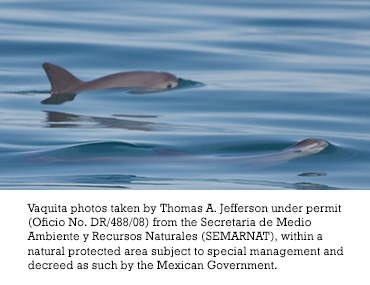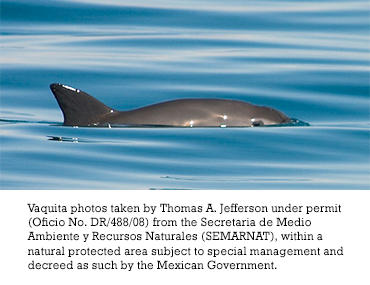

For more from Dr. Ruth MacPete, find her on Facebook or at www.drruthpetvet.com!
Vaquita photos taken by Thomas A. Jefferson under permit (Oficio No. DR/488/08) from the Secretaria de Medio Ambiente y Recursos Naturales (SEMARNAT), within a natural protected area subject to special management and decreed as such by the Mexican Government.
I must admit, even as a veterinarian who did a marine mammal rotation in Florida during veterinary school, I had never heard of the vaquita. I first learned about vaquitas from my 6-year-old daughter who studied them in her kindergarten class. When her class learned that they were critically endangered, they took action. They held a hot chocolate sale at their school and did chores at home to raise money to help them. Inspired by these amazing 6-year-olds, I wanted to see what I could do to raise awareness and support for these incredible animals.
What is a Vaquita?
The Vaquita (Phocoena, sinus), which means "little cow" in Spanish, is also known as the Gulf of California porpoise, gulf porpoise, and locally as cochito. It is an elusive porpoise first discovered in 1958 that lives only in the northern portion of the Gulf of California near the estuary of the Colorado River in the Sea of Cortez. They belong to the order Cetacea and are members of the Phocoenidae family. They are the smallest cetacean and have the smallest habitat consisting of approximately 40 square miles.

What do they look like?
Vaquitas are between 4-5 feet in length and weigh between 65-120 lbs. They are gray and have rounded heads with very little or no beak. They have black on their lips, chin and around their eyes. They are usually found alone but can be seen in pairs or in small groups of 6-8. Vaquitas are very elusive and avoid boats. They spend most of their time under water foraging and onlysurface briefly for air.
Diet
Vaquitas tend to forage in shallow waters near lagoons. They eat small fish, crustaceans, octopus and squid. It is believed that they locate their prey using echolocation.
Lifespan
Vaquitas typically live 20 years. They reach sexual maturity between 3-6 years and give birth every other year to a single calf after 10-11 month gestation, typically in March.
Endangered
The vaquita population is on the verge of extinction and is listed as critically endangered. They are the most endangered marine mammals in the world today. It is estimated that as few as 150 vaquitas remain and unless something is done within the next few years, they will become extinct. Commercial fishing is the primary reason for their decline. Vaquitas often become entangled in fishing gillnets used to catch totoaba fish and die when they are unable to surface and breathe. Like other marine mammals, they are also susceptible to environmental pollution and habitat destruction.
Rescue Efforts
Unfortunately, since the vaquita is elusive and rarely seen, their plight has gained little international attention. So what is being done to save these animals? Fortunately, the Mexican government has outlawed gillnets from their local habitat and created a nature reserve in the upper part of the Gulf of California. In order to prevent illegal fishing with gillnets, a viable solution for the local families who depend upon fishing as their sole source of incomestill needs to be found.
 What can you do?
What can you do?
When my daughter’s class learned how endangered these beautiful animals were, they immediately sprang into action. We need to all learn from these kids. If we all pitch in and try to improve the world for people and animals, just imagine what a wonderful world it would be. Here are some ideas:
- Get involved or donate money to organizations that protect animals and the environment.
- Sign petitions to outlaw gillnets and other harmful practices.
You can help vaquitas and other marine mammals with these tips:
- Don’t litter. Everything that goes down a storm drain ends up in creeks, rivers, and ultimately the ocean.
- Cut six-pack rings from soda and beer cans to prevent entanglement.
- Never throw fishing lines or fishing hooks that can entangle wildlife into the ocean.
- Don’t release balloons. These can travel hundreds of miles end up in the ocean where they can be lethal if ingested by marine animals.
For more information about ways to help visit:
- www.savethewhales.org
- http://vaquita.tv/
- http://www.cetosresearch.org/research/vaquita/vaquita.htm
- http://www.whaletrackers.com/blogs/expedition-vaquita/meet-vaquita-marina.html
- http://www.nmfs.noaa.gov/pr/species/mammals/cetaceans/vaquita.htm
If you have any questions or concerns, you should always visit or call your veterinarian – they are your best resource to ensure the health and well-being of your pets.
![]()
